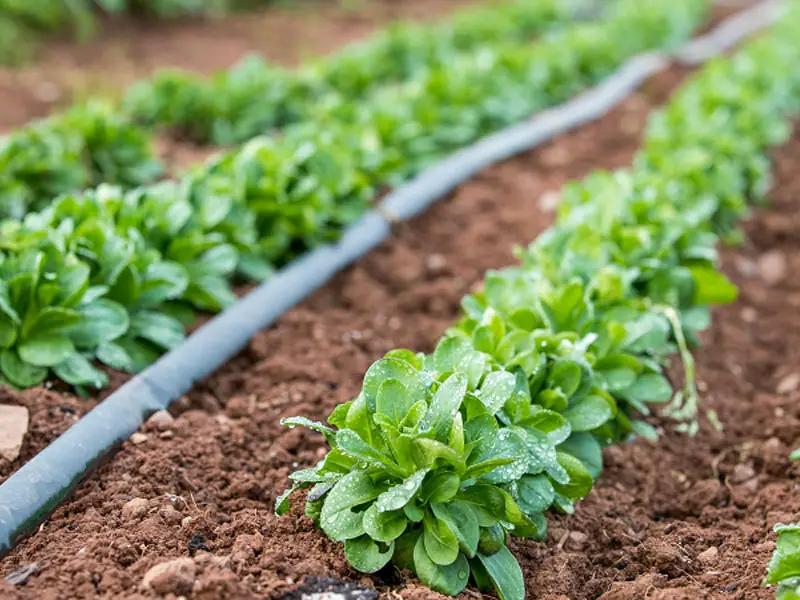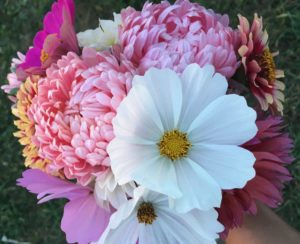Lamb’s lettuce, also known as corn salad, is a favorite crop for autumn and winter produce.
Lamb’s lettuce is very easy to grow and stands well in freezing temperatures. In some mild climate locations, this plan is considered wintergreen.
Nowadays, this leafy vegetable is a kitchen favorite for its nutty and slightly tangy flavor, not only for the making of salads but as a steamed side salad.
Lamb’s lettuce vegetables have a high content of folic acid, vitamin C, and iron.

| Scientific Name | Valerianella Locusta |
| Common Names | Corn Salad, Field salad, Rapunzel, or Winter lettuce |
| Hardiness | Hardy annual. Surprisingly frost tolerant. |
| Indoor or Outdoor Plant? | Indoor or Outdoor |
| Sun Exposure | Full Sun |
| Water | Each plant demands about 200 ml of water every 2 to 3 days. |
| Size | Up to 15cm (6 inches approx.) in height and spreads about 20cm. |
| Soil Type | Most types of soils. |
| Soil pH | Neutral pH. The ideal pH is slightly acidic, with levels between 6.5 to 7. |
| Flower | Clusters of small bluish or pink flowers. |
| Growing Difficulty Level | Very easy to grow. |
What’s Lambs Lettuce?

This field lettuce is an annual, wild, hardy, and slow-growing plant that develops in an upright bouquet.
It has rosette-like green, luscious, and small oval leaves that measure about 10 cm long.
Loaded with vitamin C, iron, and folic acid, lamb’s lettuce has a mild and characteristic nutty flavor, which and is slightly tangy when harvested young.
These lettuce plants are unusually weather tolerant. Plant them in the middle of summer to harvest in winter.
Lamb’s lettuce plants reach heights of up to 15cm (6 inches approx.) and spread to about 20cm wide.
Gardeners can plant lamb’s lettuce all year round or in unheated greenhouses.
The lamb’s lettuce plants produce little, bluish, or pinkish flower heads lavishly arranged on multi-branched stems.
Advantages of Growing Lamb’s Ear Lettuce

Growing lamb’s lettuce is not only very easy but rewarding.
Apart from giving you plenty of leaves for consumption all year round, these plants beautify your garden with a display of dark, green leaves in winter.
The lamb’s lettuce is beneficial to you too. They have a high content of antioxidants, folic acid, iron, potassium, magnesium, calcium, and Vitamins K and A.
All these minerals and vitamins are important for your body’s metabolism, immune system, and skin health.
It also plays a role in maintaining nervous system health and in lowering blood pressure.
Growing Lambs Lettuce from Seed

Lamb’s lettuce should be planted during cooler months (spring or fall) but grows well in winter, tolerating temperatures of about -20F (-28C). However, grow them in a greenhouse if there’s a risk of blustering winds or freezing rain.
Lamb’s lettuce or corn salad is best grown during the cooler months and when the soil temperature is between 50 to 70F (10 to 20C).
Here are some important steps and tips to remember:
- Sow seeds lightly in a well-prepared, fertile, moist soil in full sun or partial shade location, approximately half-inch (1cm approx) deep.
- Space seeds 1inch (2.5cm) apart and in rows of 4 inches (10cm) in between. Cover with a thin layer of compost. Water moderately.
- Germination should occur between 7-14 days.
- Apply a thick layer of mulch around the plants to help them lock moisture into the soil and remove weeds.
- Harvest lamb’s lettuce leaves when required (best before flowering) by collecting a few from each plant. This counts as well as a thinning process to give space for the production of more leaves.
- Lamb’s lettuce plants will stop growing after 70 days, depending on climate and soil conditions.
Mature plants can be harvested by removing the entire plant from the roots before cutting off the stem with the help of a knife.
Lambs’ lettuce leaves have a shelf life of up to four days when stored in the fridge, but the best taste is when they are freshly picked.
Lambs Lettuce Seeds
As stated before, you can use lettuce scraps to grow some more lettuce which it’s environmentally friendly and helps you save some money. However, it’s not the best method if you want high-quality production.
Growing lamb’s lettuce from seeds is the best practice, so obtain quality seeds from your trusted supplier.
Check out this helpful link:
Taking Care of Lambs Lettuce
After planting your lambs lettuce seeds, you will have a lot of work to do to make sure your lambs lettuce is healthy and provides a nice harvest.
Watering Lambs Lettuce
Lamb’s lettuce requires regular watering.
Each plant demands about 200 ml of water every two to three days.
Adjust the amount of water per week for container-grown lettuces according to temperature and sunlight conditions.
Episodes of dry weather may not cause the plant to die straight away but may cause damage to its leaves, which become softer and bitter.
Watering the plant is particularly is crucial for the last two weeks before harvest.
Top Tip: Loose, yellow leaves are signs of water deficiency. Overwatering will kill the plant.
Check the moisture in the soil by touching the soil about 1inch deep.
If it feels dry and sandy, then it’s time to water.
A simple checking routine will keep your lettuces fresh and growing.
Light for Lambs Lettuce
Lamb’s lettuce requires a minimum of eight hours of sunlight, with the remaining daylight hours to be in partial shade, as they need to rest from direct sunlight.
This is particularly important on really hot days.
If planted indoors, the lamb’s lettuce plants need at least 12 to 20 hours of light.
Adjust the light requirements by adopting artificial lightning at least until the first seedlings emerge.
Soil for Lambs Lettuce
The lamb’s lettuce plants can thrive in any kind of shallow, moist, and well-drained soil.
However, the soil needs to be well prepared with manure and fertilizers to produce healthy plants.
The lamb’s lettuce performs well in a neutral pH soil, but the ideal pH level is acidic between 6.5 to 7.
Temperature and Humidity for Lambs Lettuce
The lamb’s lettuce is an annual plant that grows vigorously in temperate climates, and it’s surprisingly tolerant to extreme cold when it’s well-rooted.
The ideal temperature to grow lamb lettuce is between 13 to 18C (55 to 65F).
Keeping the lamb’s lettuce growing at a cool temperature for healthy and tasty crops is important.
If it’s too cold or too hot, it will stress the seedlings making them grow tall and producing flowers and seeds before their time, compromising its taste.
By picking the mature leaves, Thinning the plants help to control the humidity and create space for the plant to grow more leaves and avoid the risk of fungus.
Potting and Re-potting Lambs Lettuce
Lamb’s lettuce is best sown in autumn, but in warmer places, it’s best in early spring.
Planting in containers allows you to move around your plant until you find the best spot for it. Here are some important steps to follow:
- Put some nutrient-rich soil in a small container, dig a hole about 1cm deep.
- Sow one seed in each hole, keeping a 1cm distance between the next hole, but scattering around your pot is good too if you don’t like the idea of making rows.
- Cover with a thin layer of soil, and press the soil down firmly with your hands. Water moderately, but always keep the soil moist.
- Once your first seedlings start to appear, remove them carefully, paying attention when manipulating the roots as they are very delicate and fragile.
- Plant each seedling about 15cm apart. Thin the older leaves to encourage new leaves and to avoid bolting. Lamb’s lettuce is ready to harvest after producing four or more pairs of leaves.
- Leaving a few plants to flower will give you seeds for new crops without your intervention (self-sown).
Propagating and Pruning Lambs Lettuce
Propagating lamb’s lettuce is very easy too. You can propagate lamb’s lettuce from scraps, making a delicious fix when on a budget.
- Cut the bottom of the lamb’s lettuce stem about 2 inches from the white bottom part up (without leaves) and place it in a small jar with about 1 inch of water.
- Freshwater is very important to succeed in the process, so it needs to be changed every one or two days.
- Place the jar in a sunny spot or under grow lights. Place it outside if the weather is mild (but out of the full sun). Keep checking the temperature and water levels.
- New growth will start appearing after a couple of days. If, after seven days nothing happens, then it probably hasn’t worked out this time. Toss out the old seeds and try again.
- Your new plant will be ready for harvest in 12 days.
You won’t produce the same quality or size lettuces with this method as growing this plant from seeds.
Water doesn’t contain the same nutrients as soil, but it is a good fix for a quick salad!
FAQ
Can you eat the flowers of Lamb’s lettuce?
This vegetable is edible raw. You can eat the whole plant (including flowers) with no side effects.
When is the best time to eat lamb’s lettuce?
Lamb’s lettuce will provide you with leaves all year round, but winter is the best time to eat it.
Will I get more lamb’s lettuce if I don’t harvest it?
No. It is very tempting for gardeners to leave the plants growing to obtain more leaves.
This is not advisable as the plants need to be thinned to give them space to grow more.
Plants that haven’t been harvested turn yellow and wilt.









Where i can buy the seeds